- Home
- G. E. Nolly
Frag Order: Enemy Inside The Gate Page 6
Frag Order: Enemy Inside The Gate Read online
Page 6
Before anyone could answer, there was a tremendous crash from a large ceiling beam that had collapsed into the Command Post, and the lights went out for Guns.
0446L, April 28, 1969
DaNang Air Base, South Vietnam
Guns Navarone awoke to a bright light shining first into his right eye, then his left. He blinked and Nurse Hunter's face came into focus.
“Kelly,” he said, “we've got to stop meeting this way.”
“Easy, sir,” Kelly said, “You’ve lost consciousness. Try not to move your head suddenly until you get your bearings. You have two broken ribs.”
He carefully sat up on the gurney and looked around.
David Rice was sitting in a plastic chair nearby. It looked like he had been up all night.
“Donny, you look like shit.”
“You should be talking, sir. How are you feeling?”
“I'll be okay.” He turned to Nurse Hunter. “Can you spring me out of this joint? The Wing Commander is on R&R, and with everything going on, I’m really needed at the Command Post.”
“I’ll go and see what I can do about a release,” she answered, “I want you to be careful. And hold a pillow up to your side and do some deep breathing exercises for those ribs.”
After Nurse Hunter left the room, Guns turned to David.
“Right before the blast, I was trying to get a hold of you-”
“About before, look, I’m sorry.”
“No, Donny, I think you may have been right about Easter. You need to tell me everything you know about this Triad. I need to know more.”
“Where should I start?”
“In my office, tomorrow morning.”
“Yes sir.”
“Have you found out anything about the bomb dump explosion?”
“I think this is Triad, too. The projectile trajectory indicates the attack came from on base.”
Nurse Hunter returned with the hospital discharge.
“Sir, I really had to pull some strings to get you released so soon. Please take it easy.”
“Okay. Thanks, Kelly.” He straightened up. “I need to get back on duty.” He looked around. “Where's my brick?”
“Over here, sir.” She reached for his hand-held radio and gave it to him. He pressed the Transmit switch just as another explosion sent waves of concussion through the hospital.
“This is Gunfighter Two. I need transport to wherever we have our temporary Command Post located.”
The radio crackled, “Right away, sir.”
As Colonel Navarone waited for his transport, he looked toward the southwest. The devastation was staggering. Gigantic fireballs blossomed into the early dawn, followed about five seconds later by deafening reports and violent concussions. The POL – petroleum, oil lubricants – storage area on the Air Force side of the base was ablaze.
A solitary O-1 aircraft was airborne, circling the base at an altitude of about 1000 feet. Guns got on his brick.
“This is Gunfighter 2. What is an aircraft doing flying over the base?”
“Sir, it's an Army Bird-dog that flew down from Phu Bai. We've been trying to make contact with him, but he's not responding.”
“Call FMS on the land-line and have them crank up one of the airplane radios onto Guard frequency and tell that guy to get the hell out of our airspace!”
“Yes, sir.”
The O-1 Bird-dog airplane was now flying directly over the Marine Bomb Dump. Just then, another explosion sent a gigantic fireball two thousand feet into the air, instantly incinerating the Bird-dog. It spiraled straight down, trailing flames as it crashed into the remains of the Freedom Hill Exchange.
The Colonel's jeep arrived, and even in the dim light he could see the devastation on the Air Force side as they drove to the makeshift Command Post. Unexploded bombs stuck out of the ground at random angles every few blocks, looking like giant lawn-darts, and there was twisted metal and shrapnel everywhere. The air-raid siren was sounding continuously.
“Sir,” the driver said, “the EOD people said that every one of those bombs has suffered heat stress, and could explode at any moment.”
“We need to get the word out to everyone to stay clear of them.” He paused and looked at the roofs of the barracks in Gunfighter Village. He saw the silhouettes of people standing on the roof tops, their figures standing out against the dark red sky. “And we need to get those guys off the roofs. The gomers would be crazy to not launch a rocket attack right now.”
He keyed the Transmit button on his brick.
“This is Gunfighter Two. We need to contact every unit commander and have him go through his alpha roster. They need to call every barracks, quarters and club and get those people into shelters.”
“Roger.”
The jeep pulled up to the temporary Command Post, and Guns rushed in. As he entered he locked eyes with Lieutenant Colonel Spade.
“Sam, do we have plans to reconstitute when the noise ends?”
“Yes, sir,” he answered, holding up an inch-thick binder labeled, OPLAN 366-178. “Right here. Pretty much everything is included. We even have preparations to secure the Freedom Hill BX with the Military Police and Air Police as soon as the explosions stop. The OPLAN has instructions that looters are to be shot on sight.”
“Sounds good to me,” Guns nodded.
The blasts continued well into the morning. At one point, some of the tear gas canisters in the Air Force bomb dump exploded, sending a cloud of CS gas wafting over sections of the base. The GIs who had disregarded the instructions to seek shelter were rewarded with coughing and watery eyes for the next several hours. Fortunately, the lethal vx gas was stored at a secure underground facility and its integrity was not damaged.
By the time the explosions had stopped, seven American military were either killed or missing, 84 were wounded, and an uncounted number of Vietnamese civilians had been killed or injured. The shanty towns that surrounded the base were devastated, as was the Freedom Hill Exchange, the R&R Center, and the POW Camp.
Reconstitution started within minutes of the final blast.
10
July 4, 1968
Bien Hoa Air Base, Vietnam
Captain Bill “Slugs” Slovak re-checked his watch as he set the clock in his F-100 cockpit. He had arrived in Vietnam less than a week earlier, and this was going to be his first combat sortie. His body still hadn’t completely caught up to the local time, and he hadn’t gotten much sleep the previous night. Partly, it was because he had been getting up to use the latrine every two hours, thanks to the gigantic orange chloroquine-primaquine-phosphate pill he had dutifully taken as directed during base in-processing. It would, they explained, help prevent Malaria. He would have to take one every week. And partly, it was because he was nervous. During his third visit to the latrine, he comically wondered if being scared shitless would cancel out the effects of the pill. No such luck.
Now, he felt drained, and was sweating profusely, even though the sun had only risen an hour earlier, and the temperature was nowhere near typical Vietnam summer heat. He knew it would really be sweltering when his flight returned, in about an hour. At exactly engine start-up time, he gave the wind-up hand signal to his crew chief and pressed the button for the cart start as he brought the throttle around the horn. The Pratt & Whitney J-57 engine dutifully started with a gigantic hissing sound and a huge cloud of white smoke from the start cartridge, and the generator came on line. Slugs listened up on the UHF radio, and in less than a minute his flight lead was calling for check-in.
“Yellow Jacket check.”
“Two.”
“Tree.”
“Four,” Slugs answered in cadence. So far so good. A fighter pilot never wants to miss his radio check-in, especially on his first flight in a new squadron.
“Ground,” Lead transmitted, “Yellow Jacket flight of four huns, taxi.”
“Roger, Yellow Jacket Flight, taxi to runway niner left.”
Yellow Jacket lead zippered his
mike switch, and four F-100 Super Sabres taxied in sequence to the arming area, located on the concrete pad at the entrance to the runway. The arming crew did a thorough inspection of the aircraft and the eight 500-pound Mark-82 bombs each aircraft carried, and pulled the safing pins from the bombs on the multiple ejector racks. The aircraft were now “hot.” On Lead’s visual signal, all four aircraft closed their canopies in unison.
This would be an in-trail takeoff, with 15 seconds spacing between aircraft. At exactly the scheduled takeoff time, the four F-100s crossed the runway Hold line and took positions in trail. Lead lit his afterburner, accelerated down the runway, and lifted off almost at its end. Fifteen seconds later, Yellow Jacket Two performed the same maneuver, followed by number Three after the appropriate delay.
Slugs pressed the button on his aircraft clock to start the sweep-second timer, looked outside the cockpit to visually acquire the three preceding F-100s in their left turn-out, and glanced back in to check his nozzle indicator as he lit the afterburner at exactly fifteen seconds. He had a good light. The aircraft seemed to accelerate a bit slower than it had in training. This was no great surprise, since in training he hadn’t been carrying four thousand pounds of bombs.
At rotation speed, with the end of the runway quickly approaching, Slugs gently pulled back on the stick, and the aircraft gracefully lifted off. He slapped the gear handle up and reached for the flap handle.
And then, as if in slow motion, the engine wound down, the aircraft noticeably sagged, and the cockpit telelight panel illuminated like a Christmas tree.
Engine failure!
Slugs knew he was too low to attempt a relight, and probably too low to bail out, too. If he bellied it in straight ahead, into the rice paddy, there was a chance he could make it. No, that wouldn’t work. The bombs were armed, and would probably detonate as soon as he hit the ground. Bailing out was the only option.
Slugs pulled up hard on the stick to try to momentarily arrest his descent rate, then quickly released the stick and and firmly pulled his lower ejection handle. He heard the rush of air as the canopy separated, and felt the jarring force as his seat initiator fired.
The next thing Slugs knew, he was descending under a fully-inflated canopy.
“I’ve made it!” he shouted.
But he had rejoiced too soon.
His parachute descended directly into the fireball of his crashed airplane, and Slugs was killed instantly, on his first combat mission.
11
April 29, 1969
DaNang Air Base, South Vietnam
Colonel Navarone was pissed. Really pissed.
“What the fuck is this all about, Major?” he bellowed, the scar on his forehead turning angry crimson, his six-foot frame towering over the Intelligence Officer as he pushed the Frag Order across the desk toward him. The Fragmentary Order was the daily mission tasking for every unit and the section for the 366th Tactical Fighter Wing was unlike anything Guns Navarone had ever seen. This Frag Order was totally different from all of the taskings up until the previous day.
As the Vice Wing Commander, Colonel Navarone checked the Frag every day after it was “broken out” – decoded. The number of sorties for the F-4C Phantom II aircraft remained unchanged, but the munitions load was decidedly different. It was absurd: one bomb, a small bomb at that, per aircraft. In fact, the 250-pound bomb, the Mark-81, was the smallest in the Air Force inventory. Pilots would derisively call them “lady fingers.” It would take three four-ship flights to carry the bomb load normally carried by one F-4.
There was a hush in the Command Post. The room had been repaired the previous day.
“Sir, I broke out the Frag myself, and called Seventh Air Force on secure voice to confirm it. They told me that this came directly from SecDef.”
It was obvious to Navarone what this was all about. It was sortie rate, to make it look like DaNang was still operating normally. McNamara wanted to keep the sortie rate up. The recent explosion of the DaNang bomb dumps had reduced munitions supplies to dangerously low levels, and until DaNang could be resupplied, they had limited resources. Anyone with any common sense knew that the intelligent thing to do was to launch fewer sorties and expose fewer crews to combat, in addition to conserving fuel and maintenance costs on the aircraft. Extra C-141 missions had already been fragged to bring in munitions on an around-the-clock basis, and a temporary bomb dump had been set up in an arch revetment. Not a perfect solution, but it would have to do until the Air Force facility was repaired.
But McNamara wanted a sortie rate.
“McNamara,” he muttered to himself, “fucking snake-oil salesman, McNamara.”
It was no secret there was no love lost between Colonel Navarone and Secretary of Defense, Robert McNamara. Navarone had hated the SecDef ever since his first tour, when he was flying thuds – F-105Ds – out of Korat Royal Air Force Base, Thailand. During Operation Rolling Thunder, the assault on targets in North Vietnam in 1967, President Johnson and McNamara had actually disclosed the targets and strike times to the North Vietnamese before every raid. Navarone figured they did it to prove to the North Vietnamese that there was nothing the gomers could do to stop the attacks, even if they knew the strike force was coming.
And, in fact, that had been true. Despite enemy aircraft, withering anti-aircraft fire and SAMs – Surface-to-Air Missiles – the F-105s got through to their targets. But the price had been high. The North Vietnamese had excellent air defense radar, and vectored their MiG-17 fighters against the American strike aircraft with deadly results.
Guns had been a Lieutenant Colonel at the time. He was the leader of four F-105Ds fragged to attack the Long Bien Bridge, nicknamed the Doumer Bridge. Their target was right “downtown”, the euphemism for Hanoi. His brother, Danny, was in the Number Two position, on his right wing. Their ingress to the target was from the west. They flew north over Laos, made a right turn to the east over Thud Ridge, and approached downtown. Three miles from the target, they were jumped by four MiG-17s, two on each side of the formation.
The F-105 was a fast airplane, with a top speed in excess of Mach 2, but it was at a distinct disadvantage in air-to-air maneuvering when weighted down with a heavy bomb load. And jettisoning the bombs short of the target to engage the enemy aircraft was not an option. If the MiGs could make the Americans salvo their munitions, they would have been successful in interdicting the American attack. And the American strike force had strict instructions from their Wing Commander.
“I want to remind all of you,” the Wing Commander had announced during the pre-strike target briefing, “that no attack aircraft has ever turned back from a target due to enemy reaction in the entire history of the Air Force.”
And the Wing Commander had been correct. During Operation Tidal Wave in 1943, the massive B-24 strike against the Ploesti oil fields, one hundred seventy-eight aircraft attacked the target. By the end of the mission, fifty-three aircraft, with six hundred sixty crewmembers, were lost. It was the costliest mission in Air Force history. Not one of the aircraft had turned back.
A flight of F-4C Phantom IIs, new to the theater, was in the target area to act as MiG-cap. The Phantoms were loaded with air-to-air munitions, AIM-7s and AIM-9s, and they had their fangs out. Guns called on strike frequency to the Phantoms to advise them that they were in an engagement as he tried to shake the MiGs off his tail. Unfortunately, the F-4s were engaged with a flight of MiGs over downtown and weren't in a position to respond. Guns was on his own.
If his flight could have jettisoned their bombs, they would have been maneuverable. It would have been a fair fight. But, Guns knew, there's no such thing as a fair fight in combat.
He performed a defensive turn to the left, with his wingmen in the loose, spread fighting wing position, but his flight of heavy F-105s was no match for the wiry MiG-17. He saw orange golf balls stream over his canopy as the enemy aircraft fired. Danny's airplane was on the outside of the turn, the most vulnerable position, and had a MiG on its
tail. Then, in a moment that would haunt him forever, Guns watched in horror as Danny took a direct hit. Danny's aircraft exploded in a large fireball, and Guns didn't observe any ejection.
His brother was lost during the attack on the Doumer Bridge. And Guns knew, in his heart of hearts, it was because of the perfidy of McNamara and Johnson. He'd harbored a hatred for both men ever since.
When Colonel Navarone had arrived at DaNang in January 1969, he took over as the new Wing Commander but in a display of pure disdain for McNamara, he did something that caused him to lose command of the 366th Tactical Fighter Wing: he pissed off Robert McNamara.
Robert McNamara had been President of Ford Motor Company before becoming Secretary of Defense. During his tenure, in 1958, Ford introduced the Edsel, a futuristic-looking car that was designed to take market share away from General Motors. But the Edsel model foundered, and was discontinued in 1960. It was the most ignominious failure in automotive history. And it was part of McNamara’s legacy. After John F. Kennedy’s defeat of Richard Nixon in the 1960 Presidential Race, the standing joke was that the definition of loser was “an unwed mother driving an Edsel with a Nixon For President bumper sticker.” No one ever mentioned the word “Edsel” in McNamara’s presence.
Shortly after Colonel Navarone took command of the 366th Tactical Fighter Wing, he was notified that Secretary of Defense McNamara would be visiting DaNang as part of his fact-finding tour of South Vietnam. Guns Navarone knew exactly what to do.
Nobody ever figured out how Navarone had arranged it in a third-world country, but when McNamara arrived, he was met by Wing Commander Navarone. It was Colonel Navarone’s job to escort McNamara all over DaNang and he did it in an Edsel!
The next day, Colonel Navarone was relieved of his command. He was demoted to Vice Wing Commander.
As far as Guns was concerned, it had been worth it.
May 5, 1969
DaNang Air Base, South Vietnam

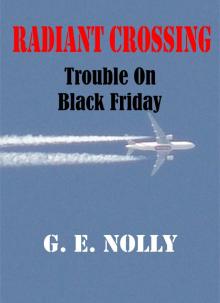 Radiant Crossing
Radiant Crossing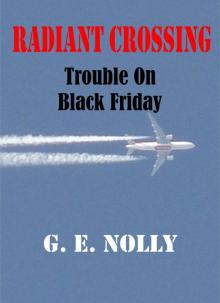 Radiant Crossing: Trouble On Black Friday (The Adventures of Hamilton Hamfist Hancock Book 5)
Radiant Crossing: Trouble On Black Friday (The Adventures of Hamilton Hamfist Hancock Book 5)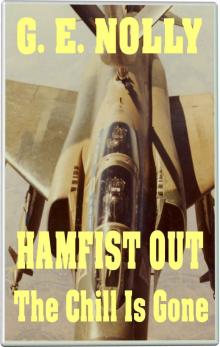 Hamfist Out: The Chill Is Gone (The Air Combat Adventures of Hamilton Hamfist Hancock Book 4)
Hamfist Out: The Chill Is Gone (The Air Combat Adventures of Hamilton Hamfist Hancock Book 4)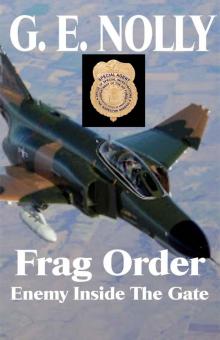 Frag Order: Enemy Inside The Gate
Frag Order: Enemy Inside The Gate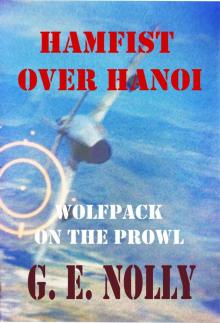 Hamfist Over Hanoi: Wolfpack on the Prowl (The Air Combat Adventures of Hamilton Hamfist Hancock Book 4)
Hamfist Over Hanoi: Wolfpack on the Prowl (The Air Combat Adventures of Hamilton Hamfist Hancock Book 4)